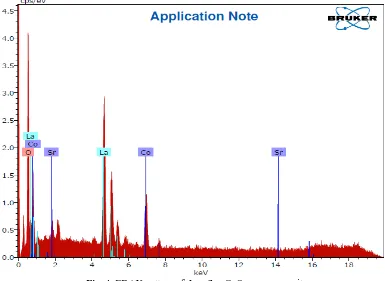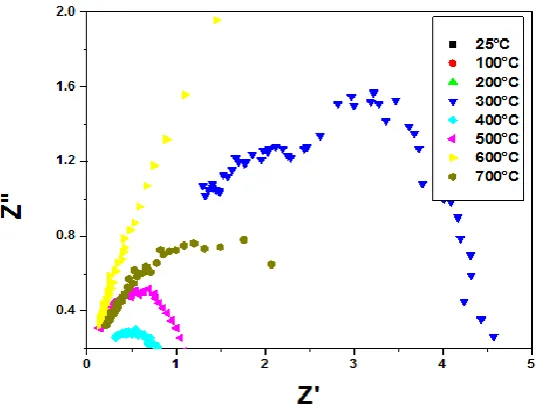Sol-Gel Preparation and Characterization of
Nanocomposite Sr-Substituted La1
-x
Sr
x
CoO
3
Perovskite Type Materials
Anjali B. Bodade, Swati M.Ghodsal, Archana B. Bodade, Gajanan N. Chaudhari*
Nanotechnology Research Laboratory, Department of Chemistry, Shri. Shivaji Science College,
Amravati, M.S, India
ABSTRACT: Nanocomposites La1-xSrxCoO3 material was synthesized by sol gel technique and calcined with
different temperatures. The structural characterizations of synthesized by X-ray diffraction, scanning electron microscopy, energy dispersive X-ray analysis and Fourier transform infrared spectra and electric properties were investigated by impedance spectroscopy. The diffraction patterns of X-ray diffraction characterization indicates that the average particle size of the nanocrystalline La0.9Sr0.1CoO3 is in the range of 30-35 nm. The frequency dependent
dielectric dispersion of nanocomposites Sr doped LaCoO3 nanomaterials were investigated by impedance spectroscopy.
The Impedance plots were used as tools to analyse the sample behaviour as a function of frequency, Cole–Cole plots and Nyquist Plot of La1-xSrxCoO3 were studied.
KEYWORDS: LaCoO3, Sol-gel method, Structural Characterization, dielectric properties.
I. INTRODUCTION
Perovskite-type metal oxides with general formula ABO3 may potentially replace noble metal catalysts due to their
high activity, thermal stability, and low costs [1]. The catalytic properties of ABO3 basically depend on the nature of A
and В ions. Therefore, the electronic properties and catalytic activity of the perovskite-type oxides can be modified by substitution of other heterovalent ions into the A or В sites [2]. Perovskite type metal oxides exhibit extremely high selectivity for oxygen due to the existence of oxygen vacancy. This is mainly because the A-site doping alkaline earth metal ions increase the concentration of oxygen vacancies, and the B-site doping transition metal ions produce mixed valence[3].
The perovskite-type oxides are non-toxic, easily handled and mild oxidizing catalysts. Despite of several advantages over traditional catalysts, they have been less explored in organic synthesis. In this study we report the effects on the structural and electrical phenomena caused by the doping of trivalent (Sr3+) cations on LaCoO3 synthesized by the sol–
gel method. LaCoO3 doped with various metal ions such as Li- and Sr[4], Mg, Ca- and Sr[5], Ca[6], Co [7], Sm3+ and
Sr2+[8], Cu-, Ni- and V [9], and Fe [10] were previously studied. The sol gel synthesized nanomaterols relies on the ability to obtain a homogeneous distribution of cations at the atomic scale and a uniform size in the nanometer range, with a simple technique that does not require high temperature and vacuum. The synthesized La1-xSrxCoO3 (x=0, 0.1)
II. EXPERIMENTAL
Nanocrystalline La1-xSrxCoO3 were prepared using sol–gel method[1]. High purity nitrates were used for the
preparation. A stoichiometric mixture cerium nitrate and zirconium nitrate were used as raw materials. A stoichiometric mixture of nit rates was mixed with equal amount of citric acid and 30 ml ethanol and stirred magnetically on hot plate at 80OC for 3h to obtain a homogenous mixture; the solution was further heated in a pressure vessel at about 130OC for 12 hrs and subsequently kept at 350OC for 3 hrs in muffle furnace and then milled to a fine powder. The dried powder was then calcined in the range of 350°C to 750OC for 6 hrs in order to improve the crystallinity and surface morphology and porosity. The morphology and size of the resulting nanomaterial was examined using Scanning Electron Microscopy (SEM). The phase of the nanomaterial was identified by X-ray Diffraction (XRD). The impedance measurements were done on the pellets (the pellets of 13.2 mm diameter and15.45 mm thickness were made by applying a pressure of 8 tons on the powered sample) by using an LCR meter. Impedance measurement were carried out in the frequency range 42 Hz-500 MHz and at temperature range 37 to 700°C[ 11]
III. RESULT AND DISCUSSION
3.1 X-ray diffraction study
The XRD patterns of the nanocomposites LaCoO3 and La1-xSrxCoO3 (x = 0,0.1) prepared by sol-gel method calcined at
650oC shown in Fig 1.. Fig. 1(A) shows XRD pattern of LaCoO3 which is in good agreement with XRD results
previously reported in the literature for LaCoO3 [12]. All the diffraction peaks of the phases are indexed as
perovskite-type with tetragonal structure. Fig. 1(B), shows the XRD pattern of La1-xSrxCoO3 (x= 0.1) nanomaterial. Extremely
broad reflections are observed indicating nanosized particle nature of the material obtained. The mean crystallite sizes (D) of La1-xSrxCoO3 (x=0,0.1) powder was deduced from half height width of XRD peaks based on the Scherer’s
equation, D = 0.9λ/βcosθ, where D is the average size of the particles, λ is wavelength of X-ray radiation, β the full width at half maximum of the diffracted peak and θ is the angle of diffraction[13]. The average particle size of the nanocrystalline La1-xSrxCoO3(x=0, 0.1) according to the Scherrer’s formula was in the range of 30–35 nm.
3.2 FTIR Analysis
Fig. 2 shows FTIR of sol-gel synthesized nanocomposites La0.9Sr0.1CoO3. The FTIR spectrum of the LaCoO3 powder
has three characteristic bands at 412.78 cm-1, 594.10 cm-1 and 659.68cm-1. The two strong absorption bands at about 594.10 cm-1and 659.68 cm-1are assigned to Co-O stretching vibration and O-Co-O deformation modes of LaCoO3,
respectively [14-17].La-O bond was assigned to the presence of the absorption band at around 415–423 cm-1 [18].
Fig. 2. FT-IR spectrum of nanocomposite La0.9Sr0.1CoO3
3.3 SEM analysis
Fig.3 shows the microstructure of nanocomposites La0.9Sr0.1CoO3 consisting of grains of Sr substituted LaCoO3. This
shows more porosity, giving largest effective surface area. SEM of La0.9Sr0.1CoO3 nanocomposites prepared by sol–gel
Fig.3 SEM micrograph of nanocomposites La0.9Sr0.1CoO3
3.4 Energy Dispersive X-ray (EDAX) Spectroscopy Analysis
IV. ELECTRICALPROPERTIES
Impedance spectral analysis
Electrical Impedance Spectroscopy (EIS) is a technique used in a wide range of applications. Electrical impedance or simply impedance, describes a measure of opposition to alternating current (a.c.). In this, AC impedance measurements are made over a wide range of frequencies and the different regions of the material are characterized according to their electrical relaxation times or time constants. Impedance spectroscopy is relatively easy to use and is applicable to a wide variety of materials and problems. A complex impedance spectrum of ceramic sample shows two distinct features intragrain (grain) and intergrain (grain boundary). Impedance data are presented in the form of Z′′ (capacitive)
and Z′ (resistive).
Fig 5(b) shows the imaginary part of impedance (Z″) for La0.9Sr0.1CoO3nanocomposites. At low temperatures below
1500C, the value of Z″ is high at low frequency and decreases with the increase of frequency indicating that electric relaxations are absent.
Fig 5 (a): Frequency dependence of real part of impedence (Z’) for La0.9Sr0.1CoO3nanocomposites
Fig. 5 (a) shows the response of the real components of impedance (Z’) with frequency for La0.9Sr0.1CoO3
nanocomposites at different temperature. It is observed that at lower frequency range, the magnitude of Z′ (grain
Fig 5 (b) : Frequencydependence of imaginary part of impedance (Z”) for La0.9Sr0.1CoO3nanocomposites
Fig 5(b) shows the imaginary part of impedance (Z″) for La0.9Sr0.1CoO3nanocomposites. At low temperatures below
1500C, the value of Z″ is high at low frequency and decreases with the increase of frequency indicating that electric relaxations are absent.
Fig.5(c).Nyquist Plot of La0.9Sr0.1CoO3
boundary. All these semicircles are not perfect semicircles, but inclined with their centers below the Z’ –Axis by an angle, which is different for each case.
V. CONCLUSION
Nanocrystalline La1-xSrxCoO3 (x=0.0.1) has been synthesized by a convenient sol–gel route. The XRD pattern of
La0.9Sr0.1CoO3 shows perovskite-type with tetragonal structure. The XRD results revealed that the particle sizeis in the
range of 30–35 nm for La0.9Sr0.1CoO3 with good crystallinity. FTIR shows two broad bands at 594.10 cm-1 and 659.68
cm-1 which indicate Co-O and O-Co-O stretching. The size of the particles, determined from the FE-SEM micrograph, is in the order of 30–35 nm . The chemical composition of compounds was confirmed from the EDAX spectrum. The value of Z’ is higher at lower frequency region and as frequency increases the value of decreases. The value of Z″ is high at low frequency and decreases with the increase of frequency indicating that electric relaxations are absent. Impedance analysis indicated the presence of grain and grain boundary effect.
ACKNOWLEDGEMENT
The authors are thankful to Principal, Shri Shivaji Science College, Amravati (MS) for providing all research facilities during research work.
REFERENCES
[1] Nyamdavaa Erdenee, Uyanga Enkhnaran, Sevjidsuren Galsan,and Altantsog Pagvajav,” Lanthanum-Based Perovskite-Type Oxides
` La1−xCexBO3 (B = Mn and Co) as Catalysts: Synthesis and Characterization” Journal of Nanomaterials, Vol 7, Issue 8, 2017
[2] Mohammad G., Houshang A. H “Electrical and CO gas sensing properties of nanostructured La1−xCexCoO3
perovskite prepared by activated reactive synthesis” Sensors and Actuators. , Vol .156, pp. 147-155, 2011.
[3] Tianyu Li, Rishvi S. Jayathilake, Daniel D. Taylorand Efrain E. Rodriguez, “Structural studies of perovskite La 1-x Sr x CoO 3-δ during
chemical looping with methane”, Chem. Commun., Vol 55, pp 4929-4932, 2019.
[4] H.P.S. Correa, C.O. Paiva-Santos, L.F. Setz, L.G. Martinez, S.R.H. Mello-CAstanho, M.T.D. Orlando, “Crystal structure refinement of
Co-doped lanthanum chromites”, Powder Diffr. Suppl. , Vol 23, S18, 2008.
[5] S.M. El-Sheikh, M.M. Rashad, “Effect of Sm3+and Sr2+ dopants on the FT-IR, “photoluminescence and surface texture of lanthanum
chromite nanoparticles” J. Alloys Compd, Vol 496, pp723–73, 2010
[6] G.-Y. Lee, R. H. Song, J.-H. Kim, D.-Y. Peck, T.-H. Lim, Y.-G. Shul, D.-R. Shin, “Properties of Cu, Ni, and V doped-LaCrO3
interconnect materials prepared by Pechini, ultrasonic spray pyrolysis and glycine nitrate processes for SOFC”, J. Electroceram , Vol 17, pp 723–727, 2006.
[7] W. Hu, Y. Ch, R.J.H. Voorhoeve, Advanced Materials in Catalysis, Academic Press, New York, 1977
[8] E. Suda, B. Pacaud, T. Seguelong, Y. Takeda, “Sintering characteristics and thermal expansion behavior of Li-doped lanthanum chromite
perovskites depending upon preparation method and Sr doping” , Solid State Ionics, Vol 151, pp 335–34, 2002.
[9] M. Mori, T. Yamamoto, T. Ichikawa, Y. Takeda, “ Dense sintered conditions and sintering mechanism for alkaline earth metal (Mg,Ca,
and Sr) – doped LaCrO3 perovskite under reducing atmosphere “,Solid State Ionics ,Vol 148, pp 93–101, 2002.
[10] N. Sakai, T. Kawada, H. Yokokawa, M. Dokiya, T. Iwata,” Sinterability and electrical conductivity of calcium-doped lanthanum chromites “, J. Mater. Sci., Vol 25, 1990 .
[11] V.D. Nithya, R. Jacob Immanuel, S.T. Senthilkumar, C. Sanjeeviraja, I. Perelshtein, D. Zitoun, R. Kalai Selvan,” Studies on the structural,
electrical and magnetic properties of LaCrO3, LaCr0.5Cu0.5O3 and LaCr0.5Fe0.5O3 by sol–gel method”, Materials Research Bulletin, Vol 47, pp 1861–1868,2012
[12] M.M. Fukate, A.B. Bodade, G.N. Chaudahry,” Efficient Nanostructure Cathode Material for Low Temperature Solid Oxide Fuel Cells:
LaSr0.5Mn0.5Co2-xFexO5+δ”, Nano Trends Vol 19 , Issue 3, pp 49-55, 2017
[13] M. Mori, T. Yamamoto, T. Ichikawa, Y. Takeda, “ Dense sintered conditions and sintering mechanism for alkaline earth metal (Mg,Ca,
and Sr) – doped LaCrO3 perovskite under reducing atmosphere “,Solid State Ionics ,Vol 148, pp 93–101, 2002.
[14] N. Sakai, T. Kawada, H. Yokokawa, M. Dokiya, T. Iwata,” Sinterability and electrical conductivity of calcium-doped lanthanum
chromites “, J. Mater. Sci., Vol 25, 1990 .
[15] X. Ding, Y. Liu, L. Gao and L. Guo, J. Alloys Compd., 458, 346–350, ,2008 .
[16] B. D. Cullity, In Elements of X-ray Diffraction, 2nd Edition, Addison Wesley, pp 155-165, 1978
[17] A. Worayingyong, P. Kangvansura, S. Kityakarn, “Pure and Ca-doped LaCoO3 Nanopowders: Sol-Gel Synthesis, Characterization and
Magnetic synthesis”, Colloid Surface A: Physicochem.Eng. Aspects, Vol 320 , Issue 123, 2008.
[18] E. Bontempi, L. Armelao, D. Barreca, L. Bertolo, G.Bottaro, E. Pierangelo, L.E. Depero,” Structural characterization of sol –gel
lanthanum cobaltite thin film “ , Crystal Eng.,Vol 5 , Issue 291, 2002.
[19] C. Matei, D. Berger, P. Marote, S. Stoleriu, J. Deloume, “ Lanthanum based perovskite obtained in molten nitrates or nitrites “ ,Prog.



